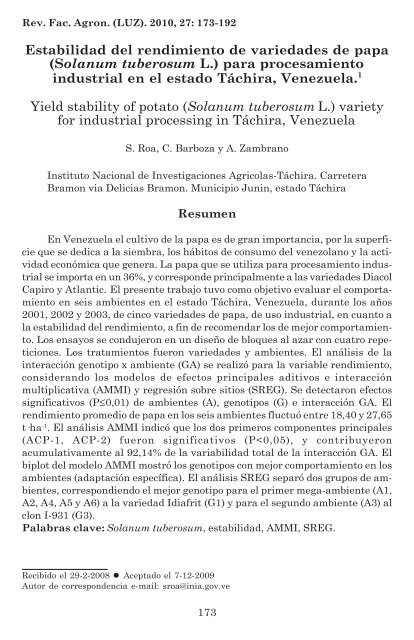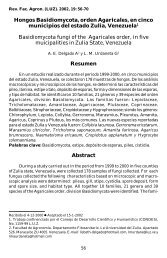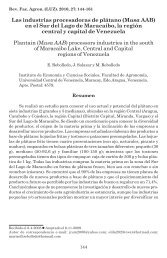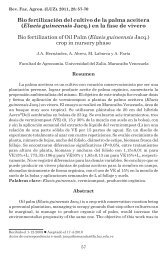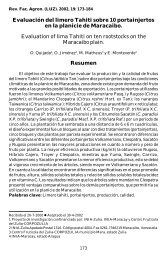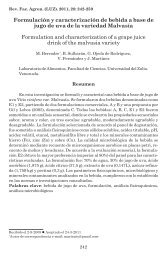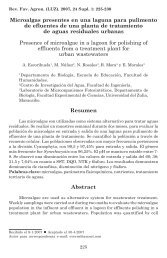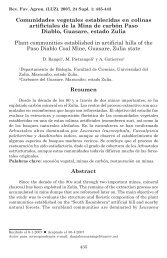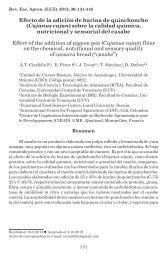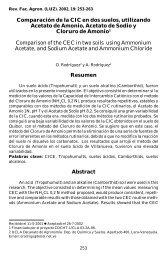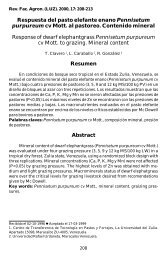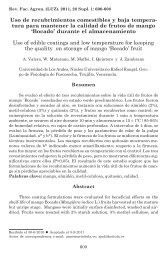Estabilidad del rendimiento de variedades de papa (Solanum ...
Estabilidad del rendimiento de variedades de papa (Solanum ...
Estabilidad del rendimiento de variedades de papa (Solanum ...
You also want an ePaper? Increase the reach of your titles
YUMPU automatically turns print PDFs into web optimized ePapers that Google loves.
Rev. Fac. Agron. (LUZ). 2010, 27: 173-192<br />
<strong>Estabilidad</strong> <strong><strong>de</strong>l</strong> <strong>rendimiento</strong> <strong>de</strong> varieda<strong>de</strong>s <strong>de</strong> <strong>papa</strong><br />
(<strong>Solanum</strong> tuberosum L.) para procesamiento<br />
industrial en el estado Táchira, Venezuela. 1<br />
Yield stability of potato (<strong>Solanum</strong> tuberosum L.) variety<br />
for industrial processing in Táchira, Venezuela<br />
S. Roa, C. Barboza y A. Zambrano<br />
Instituto Nacional <strong>de</strong> Investigaciones Agricolas-Táchira. Carretera<br />
Bramon via Delicias Bramon. Municipio Junin, estado Táchira<br />
Resumen<br />
En Venezuela el cultivo <strong>de</strong> la <strong>papa</strong> es <strong>de</strong> gran importancia, por la superficie<br />
que se <strong>de</strong>dica a la siembra, los hábitos <strong>de</strong> consumo <strong><strong>de</strong>l</strong> venezolano y la actividad<br />
económica que genera. La <strong>papa</strong> que se utiliza para procesamiento industrial<br />
se importa en un 36%, y correspon<strong>de</strong> principalmente a las varieda<strong>de</strong>s Diacol<br />
Capiro y Atlantic. El presente trabajo tuvo como objetivo evaluar el comportamiento<br />
en seis ambientes en el estado Táchira, Venezuela, durante los años<br />
2001, 2002 y 2003, <strong>de</strong> cinco varieda<strong>de</strong>s <strong>de</strong> <strong>papa</strong>, <strong>de</strong> uso industrial, en cuanto a<br />
la estabilidad <strong><strong>de</strong>l</strong> <strong>rendimiento</strong>, a fin <strong>de</strong> recomendar los <strong>de</strong> mejor comportamiento.<br />
Los ensayos se condujeron en un diseño <strong>de</strong> bloques al azar con cuatro repeticiones.<br />
Los tratamientos fueron varieda<strong>de</strong>s y ambientes. El análisis <strong>de</strong> la<br />
interacción genotipo x ambiente (GA) se realizó para la variable <strong>rendimiento</strong>,<br />
consi<strong>de</strong>rando los mo<strong><strong>de</strong>l</strong>os <strong>de</strong> efectos principales aditivos e interacción<br />
multiplicativa (AMMI) y regresión sobre sitios (SREG). Se <strong>de</strong>tectaron efectos<br />
significativos (P≤0,01) <strong>de</strong> ambientes (A), genotipos (G) e interacción GA. El<br />
<strong>rendimiento</strong> promedio <strong>de</strong> <strong>papa</strong> en los seis ambientes fluctuó entre 18,40 y 27,65<br />
t·ha -1 . El análisis AMMI indicó que los dos primeros componentes principales<br />
(ACP-1, ACP-2) fueron significativos (P
Roa et al.<br />
Abstract<br />
The Potato’s crop in Venezuela it’s very important because of <strong>de</strong>dicated<br />
surface to sowing, Venezuelan’s consummation habits and economical issues<br />
generates. The potato used for industrial processing it’s imported in a 36% and<br />
mainly fits to a variety "Diacol", "Capiro" and "Atlantic" type. The objective of<br />
this work was to evaluate yield stability of five potato genotypes used in industry<br />
processing. Potato plots were established in six ecoregions in Táchira, Venezuela<br />
during 2001, 2002 and 2003. A randomized complete block <strong>de</strong>sign with<br />
four replications was used. The interaction genotype x environment (GE) was<br />
analyzed for the yield using the additive main effect and multiple interactions<br />
(AMMI) and sites regression analysis mo<strong><strong>de</strong>l</strong>s (SREG). Significant (P
Rev. Fac. Agron. (LUZ). 2010, 27: 173-192<br />
varieda<strong>de</strong>s <strong>de</strong> las subespecies<br />
tuberosum y andígnenum (Fano,<br />
1997; Rodríguez, 2004). En el año<br />
2004 se importó el 36% <strong>de</strong> la <strong>papa</strong><br />
<strong>de</strong>stinada a procesamiento industrial<br />
y correspondió principalmente a las<br />
varieda<strong>de</strong>s Diacol Capiro y Atlantic<br />
(Gutiérrez, 2006). La importación trae<br />
como consecuencia la pérdida <strong>de</strong> divisas,<br />
por lo que se planteó la necesidad<br />
<strong>de</strong> producir en el país la mayor<br />
cantidad posible <strong>de</strong> <strong>papa</strong> para la industria;<br />
sin embargo, la variedad<br />
Atlantic resulta muy susceptible a la<br />
can<strong><strong>de</strong>l</strong>illa tardía causada por<br />
Phytophthora infestans y la variedad<br />
Diacol Capiro requiere condiciones <strong>de</strong><br />
cultivo con altitu<strong>de</strong>s superiores a los<br />
2.500 msnm lo cual crea la necesidad<br />
<strong>de</strong> evaluar nuevas varieda<strong>de</strong>s y mediante<br />
programas <strong>de</strong> mejoramiento<br />
genético crear otras adaptadas a nuestras<br />
zonas <strong>de</strong> cultivo, a fin <strong>de</strong> ampliar<br />
la oferta <strong>de</strong> varieda<strong>de</strong>s <strong>de</strong> <strong>papa</strong> para<br />
industria y procurar la producción <strong>de</strong><br />
semilla en nuestro país.<br />
Las varieda<strong>de</strong>s <strong>de</strong> <strong>papa</strong> para uso<br />
industrial <strong>de</strong>ben cumplir características<br />
<strong>de</strong> calidad interna y externa, la<br />
calidad externa está <strong>de</strong>terminada por<br />
efectos ambientales y genéticos, en<br />
cuanto a las características <strong>de</strong>terminadas<br />
por el ambiente es <strong>de</strong>seable que<br />
no presenten "ver<strong>de</strong>amiento" <strong><strong>de</strong>l</strong> tubérculo<br />
y entre las características <strong>de</strong>terminadas<br />
por efectos genéticos <strong>de</strong>ben<br />
presentar yemas (ojos) superficiales<br />
y no presentar medula externa e<br />
interna (corazón) huecas. Otras cualida<strong>de</strong>s<br />
que requieren las <strong>papa</strong>s para<br />
procesamiento industrial son el contenido<br />
<strong>de</strong> biomasa seca (mayor <strong><strong>de</strong>l</strong><br />
20%), el contenido <strong>de</strong> azúcares<br />
reductores (menor a 0,33%), y el por-<br />
2004). In 2004, 36% of potato gui<strong>de</strong>d<br />
to industrial processing was imported<br />
and mainly correspon<strong>de</strong>d to the<br />
"Diacol Capiro" and "Atlantic"<br />
varieties (Gutiérrez, 2006). The<br />
importation has as consequence the<br />
capital lost, therefore, it is necessary<br />
to produce in country the higher<br />
potato quantity for the industry;<br />
however, the "Atlantic" variety is very<br />
susceptible to late blight caused by<br />
Phytophthora infestans and "Diacol<br />
Capiro" variety required crop<br />
conditions with altitu<strong>de</strong>s higher than<br />
2.500 masl which created the<br />
necessity of evaluating new varieties<br />
and through genetic breeding<br />
programs, to create another adapted<br />
to our cultivation regions in or<strong>de</strong>r to<br />
wi<strong>de</strong> the offer of potato varieties for<br />
industry and to try seed production<br />
in our country.<br />
The potato varieties for industrial<br />
use have to fulfill internal and<br />
external quality characteristics; the<br />
internal characteristic is <strong>de</strong>termined<br />
by environmental and genetic effects,<br />
in relation to those characteristics<br />
<strong>de</strong>termined by environment is<br />
<strong>de</strong>sirable that do not shown the tuber<br />
"green spots" and between those<br />
<strong>de</strong>termined by genetic effects have to<br />
show buds (eyes) superficial and do<br />
not shown external and internal<br />
marrow (heart) empty. Other<br />
qualities required for potato industrial<br />
processing potato are the dry<br />
biomass content (higher than 20%),<br />
the content of reduced sugars (lower<br />
than 0.33%), and percentage of<br />
un<strong>de</strong>sirable color (Andra<strong>de</strong>, 1997;<br />
Perilla, 2002, Gutiérrez, 2006). The<br />
skin color of potato tubers is not<br />
related to the quality for industrial<br />
175
Roa et al.<br />
centaje <strong>de</strong> color in<strong>de</strong>seable (Andra<strong>de</strong>,<br />
1997; Perilla, 2002, Gutiérrez, 2006).<br />
El color <strong>de</strong> la peri<strong>de</strong>rmis <strong>de</strong> los tubérculos<br />
<strong>de</strong> <strong>papa</strong> no está asociado a la<br />
calidad para el procesamiento industrial<br />
y, por consiguiente, no pue<strong>de</strong> ser<br />
consi<strong>de</strong>rado como un marcador<br />
morfológico en la selección <strong>de</strong><br />
genotipos superiores relacionados a<br />
estas características (Andreu y da Silva,<br />
2007).<br />
La especie <strong>Solanum</strong> tuberosum<br />
se divi<strong>de</strong> en dos subespecies:<br />
tuberosum y andígenum. La<br />
subespecie tuberosum es la <strong>papa</strong> más<br />
cultivada en el mundo especialmente<br />
en Norte América y Europa, mientras<br />
el cultivo <strong>de</strong> la subespecie andígenum<br />
ocurre en el Centro y Sur América<br />
(Camadro, 1996; Perilla et al., 2002).<br />
La subespecie tuberosum presenta<br />
período vegetativo corto, <strong>de</strong> tres a cuatro<br />
meses, adaptación a días largos,<br />
escasa floración, poca producción <strong>de</strong><br />
bayas, período corto <strong>de</strong> reposo <strong><strong>de</strong>l</strong> tubérculo,<br />
bajo porcentaje <strong>de</strong> almidón y<br />
<strong>de</strong> biomasa seca y resistencia a ciertas<br />
razas <strong>de</strong> Phytophthora infestans.<br />
La subespecie andígenum presenta<br />
período vegetativo <strong>de</strong> cinco a siete<br />
meses, adaptación a días cortos, floración<br />
abundante y producción <strong>de</strong><br />
bayas, período largo <strong>de</strong> reposo <strong><strong>de</strong>l</strong> tubérculo,<br />
y alto porcentaje <strong>de</strong> almidón.<br />
Por lo anteriormente expuesto las<br />
varieda<strong>de</strong>s <strong>de</strong> <strong>papa</strong> con origen en la<br />
subespecie andígenum presentan más<br />
cualida<strong>de</strong>s para ser usadas en el procesamiento<br />
industrial.<br />
Los elementos meteorológicos<br />
que influyen sobre el crecimiento, <strong>de</strong>sarrollo,<br />
producción y calidad <strong>de</strong> la<br />
<strong>papa</strong> son principalmente la temperatura<br />
<strong><strong>de</strong>l</strong> suelo y aire, radiación solar,<br />
processing and, therefore, cannot be<br />
consi<strong>de</strong>red like a morphological<br />
marker in selection of genotypes superior<br />
related to these characteristics<br />
(Andreu and da Silva, 2007).<br />
The specie <strong>Solanum</strong> tuberosum<br />
is divi<strong>de</strong>d in two sub-species:<br />
tuberosum and andígenum. The subspecie<br />
tuberosum is the more<br />
cultivated potato in world especially<br />
in North America and Europe,<br />
whereas the cultivation of sub-specie<br />
andígenum occurs in Central and<br />
South America (Camadro, 1996; Perilla<br />
et al., 2002). The sub-specie<br />
tuberosum shows a short vegetative<br />
period, from three to four months,<br />
adaptability to long days, limited<br />
flowering, little berries production,<br />
short period of tuber rest, low starch<br />
percentage and dry biomass and<br />
resistance to some races of<br />
Phytophthora infestans. The subspecie<br />
andígenum show a vegetative<br />
period of five to seven months,<br />
adaptability to short days, abundant<br />
flowering and production of berries,<br />
long period of tuber rest, and high<br />
starch percentage. The potato<br />
varieties with origin in the sub-specie<br />
andígenum show more qualities to be<br />
used on industrial processing.<br />
The metereological elements<br />
takes influence on growth, <strong>de</strong>veloping,<br />
production and quality of potato are<br />
mainly soil and air temperature, solar<br />
radiation, photoperiod, soil<br />
humidity and evapotranspiration.<br />
Climate <strong>de</strong>termines the length of<br />
plants <strong>de</strong>veloping period and permits<br />
to establish the sowing times.<br />
The evaluation of genotypes in<br />
different localities and through time<br />
is important to estimate the genotypic<br />
176
Rev. Fac. Agron. (LUZ). 2010, 27: 173-192<br />
fotoperíodo, humedad <strong><strong>de</strong>l</strong> suelo y<br />
evapotranspiración. El clima <strong>de</strong>termina<br />
la longitud <strong><strong>de</strong>l</strong> período <strong>de</strong> <strong>de</strong>sarrollo<br />
<strong>de</strong> las plantas y permite establecer<br />
las épocas <strong>de</strong> siembra.<br />
La evaluación <strong>de</strong> los genotipos<br />
en diferentes localida<strong>de</strong>s y a través <strong><strong>de</strong>l</strong><br />
tiempo, es importante para estimar<br />
las respuestas genotípicas diferenciales<br />
bajo diversas condiciones ambientales.<br />
Para la obtención <strong>de</strong> nuevas<br />
varieda<strong>de</strong>s es necesario evaluar los<br />
materiales en diferentes ambientes y<br />
medir su interacción genotipo- x ambiente,<br />
la cual da una i<strong>de</strong>a <strong>de</strong> la estabilidad<br />
fenotípica <strong>de</strong> las varieda<strong>de</strong>s<br />
ante las fluctuaciones ambientales. La<br />
estabilidad se consi<strong>de</strong>ra como una serie<br />
<strong>de</strong> condiciones intrínsecas <strong>de</strong> un<br />
cultivar que hacen que pueda sortear<br />
con menores variaciones entre distintos<br />
años las condiciones climáticas <strong>de</strong><br />
cada sitio (Kraan y Di Pane, 2009).<br />
Las interacciones genotipo x<br />
ambiente son importantes fuentes <strong>de</strong><br />
variación en cualquier cultivo y el término<br />
estabilidad es usado para caracterizar<br />
genotipos que muestran <strong>rendimiento</strong>s<br />
relativamente constantes,<br />
in<strong>de</strong>pendientemente <strong>de</strong> las condiciones<br />
ambientales cambiantes, entonces,<br />
los genotipos con una mínima<br />
variación en el <strong>rendimiento</strong> a través<br />
<strong>de</strong> diferentes ambientes son consi<strong>de</strong>rados<br />
estables (Sabaghnia et al.,<br />
2006).<br />
Una <strong>de</strong> las formas <strong>de</strong> medir estabilidad<br />
en el comportamiento es por<br />
medio <strong>de</strong> un análisis <strong>de</strong> regresión <strong>de</strong><br />
los valores individuales en un índice<br />
ambiental, <strong>de</strong>finido como el promedio<br />
<strong>de</strong> todas las varieda<strong>de</strong>s en el j-ésimo<br />
ambiente, menos la media general.<br />
Una variedad se consi<strong>de</strong>ra estable si<br />
differential responses un<strong>de</strong>r different<br />
environmental conditions. To obtain<br />
new varieties is necessary to evaluate<br />
materials in different environments<br />
and to measure the interaction<br />
genotype x environment, which gives<br />
an i<strong>de</strong>a of the phenotypical stability<br />
of varieties in front of environmental<br />
fluctuations. The stability consi<strong>de</strong>r<br />
like a serial of intrinsic conditions of<br />
a cultivar that makes possible with<br />
lower variations between different<br />
years the climatic conditions of any<br />
place (Kraan and Di Pane, 2009).<br />
The interaction genotype x<br />
environment are important variation<br />
sources in any crop and term stability<br />
is used to characterize genotypes<br />
showing relatively constant yields,<br />
in<strong>de</strong>pen<strong>de</strong>ntly on changing<br />
environmental conditions, then,<br />
genotypes with a minimum variation<br />
in yield through different<br />
environments are consi<strong>de</strong>red stables<br />
(Sabaghnia et al., 2006).<br />
One of ways of measuring<br />
stability in behavior is through a<br />
regression analysis of individual<br />
values on an environmental in<strong>de</strong>x,<br />
<strong>de</strong>fined like the average of every<br />
variety in the j-ésimo environment,<br />
un<strong>de</strong>r general mean. A variety is<br />
consi<strong>de</strong>red stable if its regression<br />
coefficient is 1 and its <strong>de</strong>viation is zero<br />
(Eberhart and Russel, 1966). This<br />
analysis has been successfully used to<br />
select <strong>de</strong>sirable potato genotypes<br />
(Haydar et al., 2009).<br />
The term genotype x<br />
environment (GE) interaction in general<br />
refers to the variation on<br />
production can not be explained by the<br />
main effect of genotype (G) and the<br />
main effect of environment (A), (Yan<br />
177
Roa et al.<br />
su coeficiente <strong>de</strong> regresión es 1 y su<br />
<strong>de</strong>sviación es cero (Eberhart y Russel,<br />
1966). Este análisis ha sido utilizado<br />
con éxito para seleccionar genotipos<br />
<strong>de</strong> <strong>papa</strong> <strong>de</strong>seables (Haydar, et al.,<br />
2009).<br />
El término interacción genotipo<br />
x ambiente (GA) por lo general se refiere<br />
a la variación en la producción<br />
que no pue<strong>de</strong> ser explicada por el efecto<br />
principal <strong><strong>de</strong>l</strong> genotipo (G) y el efecto<br />
principal <strong><strong>de</strong>l</strong> ambiente (A), (Yan y<br />
Hunt, 2001). La existencia <strong>de</strong> la<br />
interacción GA frecuentemente dificulta<br />
los progresos en los programas<br />
<strong>de</strong> mejoramiento genético ya que complica<br />
la evaluación y selección <strong>de</strong> los<br />
genotipos superiores (Rodríguez et al.,<br />
2008; González et al., 2007). Existen<br />
varias metodologías para enfrentar el<br />
problema <strong>de</strong> la interacción GA, siendo<br />
un alternativa el mo<strong><strong>de</strong>l</strong>o <strong>de</strong>nominado<br />
AMMI (Additive Main Effects<br />
and Multiplicative Interaction)<br />
(Gauch, 1988; González et al., 2003),<br />
que combina el análisis <strong>de</strong> varianza<br />
ordinario con el análisis <strong>de</strong> componentes<br />
principales (ACP), don<strong>de</strong> el ACP<br />
es utilizado en la <strong>de</strong>scomposición <strong>de</strong><br />
la interacción GA en componentes<br />
multiplicativos. Este mo<strong><strong>de</strong>l</strong>o pue<strong>de</strong><br />
ser útil para la i<strong>de</strong>ntificación <strong>de</strong><br />
genotipos <strong>de</strong> alta productividad y<br />
adaptabilidad, zonificación <strong>de</strong> cultivos<br />
con fines <strong>de</strong> recomendación regional<br />
y selección <strong>de</strong> localida<strong>de</strong>s <strong>de</strong> evaluación.<br />
Otro método importante para la<br />
evaluación <strong>de</strong> los cultivares e i<strong>de</strong>ntificación<br />
<strong>de</strong> mega-ambientes es el<br />
biplot GGE, que resulta <strong>de</strong> combinar<br />
el efecto <strong><strong>de</strong>l</strong> genotipo (G) más el efecto<br />
<strong>de</strong> la interacción GA (G + GA) (Yan<br />
et al., 2000). El gráfico biplot permite<br />
i<strong>de</strong>ntificar el genotipo <strong>de</strong> mayor poand<br />
Hunt, 2001). The existence of GE<br />
interaction frequently makes difficult<br />
the progresses of genetic breeding<br />
programs because the evaluation and<br />
selection of superior genotypes is<br />
complicated (Rodríguez et al., 2008;<br />
González et al., 2007). There are<br />
several methodologies to confront the<br />
problem of GE interaction, being an<br />
alternative the mo<strong><strong>de</strong>l</strong> called AMMI<br />
(Additive Main Effects and<br />
Multiplicative Interaction) (Gauch,<br />
1988; González et al., 2003), by<br />
combining the common analysis of<br />
variance with the principal<br />
components analysis (PCA), where<br />
the last one is used in <strong>de</strong>composition<br />
of GE interaction on multiplicative<br />
components. This mo<strong><strong>de</strong>l</strong> can be useful<br />
for the i<strong>de</strong>ntification of high<br />
productivity and adaptability<br />
genotypes, crops location with<br />
purposes of regional recommendation<br />
and selection of evaluation regions.<br />
Other important method for the<br />
cultivars evaluation and<br />
i<strong>de</strong>ntification of mega-environments<br />
is the biplot GGE, resulting of<br />
combining the effect of genotype (G)<br />
more the effect of the GE interaction<br />
(G + GE) (Yan et al., 2000). The biplot<br />
graphic permits to i<strong>de</strong>ntify the<br />
genotype of higher potential at any<br />
environment and to group genotypes<br />
and environments with similar<br />
response patterns (Ibáñez et al.,<br />
2006).<br />
This research had as objective<br />
to evaluate behavior of different<br />
varieties environments and potato<br />
advanced clones of industrial use, in<br />
relation to the yield stability, with the<br />
purpose of recommend those of best<br />
behavior to be used in breeding<br />
178
Rev. Fac. Agron. (LUZ). 2010, 27: 173-192<br />
tencial en cada ambiente y agrupar<br />
genotipos y ambientes con patrones<br />
similares <strong>de</strong> respuesta (Ibáñez et al.,<br />
2006).<br />
El presente trabajo tuvo como<br />
objetivo evaluar el comportamiento en<br />
diferentes ambientes <strong>de</strong> varieda<strong>de</strong>s y<br />
clones avanzados <strong>de</strong> <strong>papa</strong> <strong>de</strong> uso industrial,<br />
en cuanto a la estabilidad <strong>de</strong><br />
su <strong>rendimiento</strong>, a fin <strong>de</strong> recomendar<br />
los <strong>de</strong> mejor comportamiento para ser<br />
utilizados en programas <strong>de</strong> mejoramiento<br />
o para producción <strong>de</strong> <strong>papa</strong><br />
para uso industrial.<br />
Materiales y métodos<br />
Los ensayos se realizaron en cinco<br />
localida<strong>de</strong>s <strong>de</strong> los Municipios<br />
Jáuregui y Michelena <strong><strong>de</strong>l</strong> estado<br />
Táchira, con temperaturas promedio<br />
anuales <strong>de</strong> 14,9 y 15,4ºC, respectivamente<br />
(cuadro 1), durante los años<br />
2001, 2002 y 2003. En cada localidad,<br />
en todos o en algunos <strong>de</strong> los años, se<br />
evaluaron las varieda<strong>de</strong>s Idiafrit (G1),<br />
Diacol Capiro (G2), Fri<strong>papa</strong> (G4), y los<br />
clones avanzados I-931(G3) e I-1062<br />
(G5), <strong>de</strong>nominados los genotipos para<br />
los efectos <strong><strong>de</strong>l</strong> presente trabajo, con<br />
cualida<strong>de</strong>s para procesamiento industrial;<br />
suministrados por el Centro Internacional<br />
<strong>de</strong> la <strong>papa</strong> (CIP) como<br />
vitroplántulas a partir <strong>de</strong> las cuales<br />
se obtuvieron los tubérculos-semilla<br />
utilizados en los ensayos.<br />
Los ensayos se instalaron en un<br />
diseño <strong>de</strong> bloques al azar con cuatro<br />
repeticiones y cinco tratamientos (varieda<strong>de</strong>s<br />
y clones avanzados), en parcelas<br />
<strong>de</strong> cuatro surcos por tratamiento<br />
y 24 plantas por surco, la distancia<br />
<strong>de</strong> siembra fue 0,90 m entre surcos y<br />
0,40 m entre plantas. Se cosecharon<br />
programs or for potatoes production<br />
for industrial use.<br />
Materials and methods<br />
Essays were carried out on five<br />
locations of "Jáuregui" and<br />
"Michelena" municipalities of Táchira<br />
state, with annual mean<br />
temperatures of 14.9 and 15.4ºC,<br />
respectively (table 1), during 2001,<br />
2002 and 2003. At any locality, in all<br />
or in some years, the "Idiafrit" (G1),<br />
"Diacol Capiro" (G2), "Fri<strong>papa</strong>" (G4)<br />
varieties were evaluated and the<br />
advanced clones I-931(G3) and I-1062<br />
(G5), called the genotypes for the<br />
effects of this research, with qualities<br />
for industrial processing; supplied by<br />
the "Centro Internacional <strong>de</strong> la Papa"<br />
(CIP) like vitro seedlings from which<br />
the tubers-seed used in this essay<br />
were obtained.<br />
Essays were accomplished on at<br />
random blocks <strong>de</strong>sign with four<br />
replications and five treatments<br />
(varieties and advanced clones), in<br />
plots of four furrows per treatment and<br />
24 plants by furrow, the sowing<br />
distance was 0.90 m between furrows<br />
and 0.40 m between plants. Plants<br />
obtained from the two central furrows<br />
were harvested. In table 2 the soils<br />
characteristics of evaluated<br />
environments are shown. The essay<br />
fertilization consisted in the<br />
application of 1.500 kg.ha -1 of formula<br />
12-12-17-2 at the moment of sowing<br />
and 500 kg.ha -1 of potassium sulphate<br />
and calcium nitrate mixing in aporque,<br />
ma<strong>de</strong> at 40 days after sowing. Foliar<br />
fertilizer was applied each 15 days<br />
after flowering in doses of 2 L.ha -1 .<br />
Herbici<strong>de</strong> was applied in pre-emergent<br />
179
Roa et al.<br />
Cuadro 1. Características <strong>de</strong> los seis ambientes <strong><strong>de</strong>l</strong> estado Táchira<br />
utilizados para la evaluación <strong>de</strong> cinco genotipos <strong>de</strong> <strong>papa</strong>.<br />
Table 1. Characteristics of six environments of Táchira state used for<br />
the evaluation of five potato genotypes.<br />
Ambiente Localidad Ubicación Fecha <strong>de</strong> Altitud<br />
geográfica siembra (msnm)<br />
A1 LLano Largo 08º13´43,5´´ LN 14/06/2001 2.308<br />
(Mcpio. Jáuregui) 71º55´58´´ LO<br />
A2 LLano Largo 08º13´43,5´´ LN 22/05/2002 2.308<br />
(Mcpio. Jáuregui) 71º55´58´´ LO<br />
A3 Angarabeca 07º 59´53,8´´ LN 10/06/2002 2.430<br />
(Mcpio. Michelena) 72º 8´57,9´´ LO<br />
A4 Pueblo Hondo 08° 17´ LN 07/07/2003 2.510<br />
(Mcpio. Jáuregui) 71° 52´ LO<br />
A5 Sabana Gran<strong>de</strong> 08º 13´19,7´´ LN 05/05/2003 2.293<br />
(Mcpio. Jáuregui) 71º 56´11,7´´ LO<br />
A6 La Pra<strong>de</strong>ra 08º 12´28,2´´ LN 10/07/2003 2.025<br />
(Mcpio. Jáuregui) 71º 56´ 52,5´´LO<br />
las plantas <strong>de</strong> los dos surcos centrales.<br />
En el cuadro 2 se presentan las<br />
características <strong>de</strong> los suelos en los<br />
ambientes evaluados. La fertilización<br />
<strong>de</strong> los ensayos consistió en la aplicación<br />
<strong>de</strong> 1.500 kg.ha -1 <strong>de</strong> la fórmula 12-<br />
12-17-2 al momento <strong>de</strong> la siembra y<br />
500 kg.ha -1 <strong>de</strong> la mezcla <strong>de</strong> Sulfato <strong>de</strong><br />
Potasio y Nitrato <strong>de</strong> Calcio en el<br />
aporque, que se realizó a los 40 días<br />
<strong>de</strong>spués <strong>de</strong> la siembra. Se aplicó fertilizante<br />
foliar cada 15 días <strong>de</strong>spués<br />
<strong>de</strong> la floración en dosis <strong>de</strong> 2 L.ha -1 . Se<br />
aplicó herbicida en forma<br />
preemergente. El riego se efectuó semanalmente<br />
por aspersión. Se realizaron<br />
aplicaciones preventivas <strong>de</strong><br />
fungicidas para controlar la can<strong><strong>de</strong>l</strong>illa<br />
tardía causada por P. infestans. Las<br />
variables evaluadas fueron: <strong>rendimiento</strong><br />
(t.ha -1 ), duración <strong><strong>de</strong>l</strong> ciclo, es<br />
<strong>de</strong>cir, días transcurridos <strong>de</strong>s<strong>de</strong> siemway.<br />
Irrigation was weekly sprinkled.<br />
Fungici<strong>de</strong> preventive applications were<br />
accomplished to control the late blight<br />
caused by P. infestans. The evaluated<br />
variables were: yield (t.ha -1 ), cycle<br />
duration, that is, days from sowing to<br />
harvest (<strong>de</strong>termined by plants<br />
yellowing and epi<strong>de</strong>rmis fixation),<br />
flowering at 60 days after sowing (das),<br />
flowers color and characteristics:<br />
shape, epi<strong>de</strong>rmis color and mean<br />
biomass of tubers (g) in a sample of 20<br />
tubers by genotype at any essay.<br />
Because the <strong>de</strong>sign was not reached<br />
in relation to the year factor, because<br />
not always the same sowing were used<br />
any year (table 1); each location and<br />
year was consi<strong>de</strong>red as one<br />
environment, thus, six environments<br />
were generated. The statistical<br />
analysis was ma<strong>de</strong> for data of yield<br />
variable.<br />
180
Rev. Fac. Agron. (LUZ). 2010, 27: 173-192<br />
Cuadro 2. Características <strong>de</strong> los suelos en los seis ambientes evaluados.<br />
Table 2. Characteristics of soils in six evaluated environments.<br />
Ambientes pH M.O. K P Ca Mg CE Textura<br />
ppm ppm ppm ppm<br />
A1 y A2 5,55 5,02 94 442 361 41 0,256 Franco-arenoso<br />
A3 6,27 3,62 96 195 869 60 0,294 Franco-arenoso<br />
A4 4,89 7,25 120 178 298 33 - Franco<br />
A5 5,35 5,94 83 171 486 38 - Franco-arenoso<br />
A6 5,78 4,79 100 300 342 42 0,198 Franco-arenoso<br />
bra a cosecha (la cual se <strong>de</strong>terminó<br />
por el amarillamiento <strong>de</strong> las plantas<br />
y la fijación <strong>de</strong> la epi<strong>de</strong>rmis), floración<br />
a los 60 días <strong>de</strong>spués <strong>de</strong> la siembra<br />
(dds), color <strong>de</strong> las flores y las características:<br />
forma, color <strong>de</strong> la epi<strong>de</strong>rmis<br />
y biomasa promedio <strong>de</strong> los tubérculos<br />
(g) en una muestra <strong>de</strong> 20 tubérculos<br />
por genotipo en cada ensayo. Debido<br />
a que el diseño no fue balanceado en<br />
cuanto al factor año, porque no siempre<br />
se utilizaron los mismos sitios <strong>de</strong><br />
siembra en cada año (cuadro 1), se<br />
consi<strong>de</strong>ró cada localidad y año como<br />
un ambiente, por lo que se generaron<br />
seis ambientes. Los análisis estadísticos<br />
se realizaron para los datos <strong>de</strong><br />
la variable <strong>rendimiento</strong>.<br />
Los mo<strong><strong>de</strong>l</strong>os lineal-bilineal utilizados<br />
fueron los <strong>de</strong> efectos principales<br />
aditivos e interacción<br />
multiplicativa (AMMI) y los <strong>de</strong> regresión<br />
<strong>de</strong> sitios (SREG). El análisis estadístico<br />
se realizó utilizando el programa<br />
SAS para graficar biplots GE<br />
(mo<strong><strong>de</strong>l</strong>o AMMI) y GGE (mo<strong><strong>de</strong>l</strong>o<br />
SREG) <strong>de</strong> Burgueño et al., 2001.<br />
El mo<strong><strong>de</strong>l</strong>o AMMI fue:<br />
∑<br />
t<br />
ij = + i + j +<br />
k = 1 k ik jk + ij<br />
y µ τ δ λ α γ ε<br />
y el mo<strong><strong>de</strong>l</strong>o SREG fue<br />
The lineal-bi-lineal mo<strong><strong>de</strong>l</strong>s used<br />
were the main additive effects and<br />
multiplicative interaction (AMMI)<br />
and those of sites regression (SREG).<br />
The statistical analysis was carried<br />
out using the SAS program to graphic<br />
GE biplots (mo<strong><strong>de</strong>l</strong> AMMI) and GGE<br />
(mo<strong><strong>de</strong>l</strong> SREG) of Burgueño et al.,<br />
2001.<br />
The mo<strong><strong>de</strong>l</strong> AMMI was:<br />
∑<br />
t<br />
ij = + i + j +<br />
k = 1 k ik jk + ij<br />
y µ τ δ λ α γ ε<br />
and mo<strong><strong>de</strong>l</strong> SREG was<br />
∑<br />
y = µ + δ + λ α γ + ε<br />
ij j k=<br />
1 k ik jk ij<br />
where y<br />
ij = mean of cultivar i-<br />
ésimo in environment j-ésimo<br />
µ= global mean<br />
τ i<br />
= genotype effect<br />
δ j<br />
= locality effect<br />
λ k<br />
(λ 1<br />
≥ λ 2<br />
≥ λ t<br />
)= singular value<br />
y α ik<br />
= (α 1k<br />
,…,α γk<br />
) y<br />
γ jk<br />
=(γ 1k<br />
,…,γ ek<br />
)= singular vector for cultivar<br />
and site respectively (restricted<br />
to for)<br />
ε<br />
ij = residual error (NID was<br />
assumed (0,σ 2 /r), where σ 2 was the<br />
error variance and r was the nº of<br />
replications).<br />
In the AMMI mo<strong><strong>de</strong>l</strong>, term<br />
t<br />
181
Roa et al.<br />
∑<br />
t<br />
= + + +<br />
ij j k=<br />
1 k ik jk ij<br />
y µ δ λ α γ ε<br />
Don<strong>de</strong> y ij<br />
= media <strong><strong>de</strong>l</strong> cultivar i-<br />
ésimo en el j-ésimo ambiente<br />
µ= media global<br />
t i<br />
= efecto genotipo<br />
δ j<br />
= efecto localidad<br />
λ k<br />
(λ 1<br />
≥ λ 2<br />
≥ λ t<br />
)= valor singular<br />
α ik<br />
= (α 1k<br />
,…,α γk<br />
) y γ jk<br />
=(γ 1k<br />
,…,γ ek<br />
) =<br />
vector singular para cultivar y sitio<br />
respectivamente (restringido a ∑ i<br />
α ik<br />
= ∑ j<br />
γ ik<br />
= 1 y ∑ i<br />
α ik<br />
α ik’<br />
= ∑ j<br />
γ jk<br />
γ jk’<br />
= 0<br />
2 2<br />
para k = k’)<br />
ε ij<br />
= error residual (se asumió<br />
NID (0,σ 2 /r), don<strong>de</strong> σ 2 fue la varianza<br />
<strong><strong>de</strong>l</strong> error y r fue el nº <strong>de</strong> repeticiones).<br />
En el mo<strong><strong>de</strong>l</strong>o AMMI, el término<br />
interacción genotipo x ambiente (GA)<br />
fue absorbido en el término bilineal y<br />
en el mo<strong><strong>de</strong>l</strong>o SREG los efectos principales<br />
<strong>de</strong> los cultivares (G) mas el término<br />
IGA fueron absorbidos en el término<br />
bilineal. El término bilineal fue<br />
sujeto a <strong>de</strong>scomposición a través <strong><strong>de</strong>l</strong><br />
valor singular (DVS). Con el procedimiento<br />
DVS, se obtuvo la suma <strong>de</strong> cuadrados<br />
<strong>de</strong> los términos AMMI, los cuales<br />
correspondieron simplemente al<br />
cuadrado <strong>de</strong> cada uno <strong>de</strong> los valores<br />
singulares. Posteriormente se obtuvieron<br />
las coor<strong>de</strong>nadas genotípicas<br />
0.5<br />
0.5<br />
( λk<br />
α<br />
ik<br />
) y ambientales ( λk<br />
γ<br />
jk<br />
) a<br />
partir <strong>de</strong> las cuales se construyó el gráfico<br />
(biplot). El programa creado en<br />
SAS para obtener mo<strong><strong>de</strong>l</strong>os AMMI <strong>de</strong><br />
Burgueño et al., (2001), incluyó la prueba<br />
<strong>de</strong> Gollob, (1967); para <strong>de</strong>terminar<br />
la significación <strong>de</strong> cada término<br />
AMMI.<br />
Resultados y discusión<br />
Al realizar el análisis <strong>de</strong><br />
varianza (ANOVA) <strong>de</strong> los datos ob-<br />
interaction genotype x environment<br />
(GA) was absorbed in bi-lineal term<br />
and in the SREG mo<strong><strong>de</strong>l</strong>, the principal<br />
effects of cultivars (G) more the<br />
IGA term were absorbed in the bi-lineal<br />
term. The bi-lineal term was<br />
subject to <strong>de</strong>composition through singular<br />
value (DSV). With the DVS<br />
procedure, the sum of squares of<br />
AMMI terms was obtained which<br />
simply correspon<strong>de</strong>d to the square of<br />
each singular values. After that, the<br />
0.5<br />
genotypic coordinates ( λk<br />
α ) and<br />
0.5<br />
ik<br />
environmental ( λk<br />
γ<br />
jk) were also<br />
obtained from which the graphic<br />
(biplot) was done. The program<br />
created on SAS to obtain the AMMI<br />
mo<strong><strong>de</strong>l</strong>s of Burgueño et al., (2001),<br />
inclu<strong>de</strong>d Gollob test, (1967); to <strong>de</strong>termine<br />
the significance of each AMMI<br />
term.<br />
Results and discussion<br />
At the moment of accomplishing<br />
the analysis of variance (ANOVA) of<br />
data obtained for yield, highly<br />
significant differences were found<br />
(P
Rev. Fac. Agron. (LUZ). 2010, 27: 173-192<br />
tenidos para <strong>rendimiento</strong> se encontraron<br />
diferencias altamente significativas<br />
(P
Roa et al.<br />
variedad Fri<strong>papa</strong> (G4) y el mayor <strong>rendimiento</strong><br />
a Idiafrit (G1). El <strong>rendimiento</strong><br />
promedio más alto (36,4 10,3 t.ha -1 )<br />
se obtuvo en el ambiente 3<br />
(Angarabeca, Mcpio. Michelena) y el<br />
menor <strong>rendimiento</strong> promedio (11,7<br />
4,3 t.ha -1 ) en el ambiente 2 (Llano<br />
Largo, Mcpio. Jáuregui) lo cual explicó<br />
la influencia <strong>de</strong> las condiciones<br />
ambientales sobre los genotipos en los<br />
diferentes ciclos <strong>de</strong> siembra, aunque<br />
no se obtuvieron datos climatológicos<br />
que permitieran examinar las variables<br />
climáticas tan importantes para<br />
la respuesta favorable <strong>de</strong> los cultivos.<br />
El análisis AMMI <strong>de</strong>terminó que los<br />
dos primeros términos fueron significativos<br />
(P
Rev. Fac. Agron. (LUZ). 2010, 27: 173-192<br />
Figura 1. Biplot AMMI <strong>de</strong> cinco genotipos <strong>de</strong> <strong>papa</strong> evaluados en seis<br />
ambientes.<br />
Figure 1. Biplot AMMI of five potato genotypes evaluated in six<br />
environments.<br />
ambiente A3. En este análisis, los<br />
genotipos <strong>de</strong> mayor producción con<br />
respecto al promedio se ubicaron en<br />
la parte positiva <strong><strong>de</strong>l</strong> componente ACP-<br />
2, y los genotipos <strong>de</strong> menor producción<br />
al promedio se ubicaron en la<br />
parte negativa.<br />
Las interacciones correspondientes<br />
a la parte multiplicativa <strong><strong>de</strong>l</strong> mo<strong><strong>de</strong>l</strong>o<br />
AMMI, se estimaron a partir <strong>de</strong> los<br />
puntajes ACP-1 y ACP-2 <strong>de</strong> los<br />
genotipos y ambientes. Los genotipos<br />
<strong>de</strong> menor efecto <strong>de</strong> interacción promedio<br />
correspondieron a G3 y G1, probablemente<br />
por ser los más estables. El<br />
genotipo con mayor efecto <strong>de</strong><br />
interacción promedio fue el G-4 lo cual<br />
the specific adaptability of materials<br />
and shows that genotypes have to be<br />
selected by having interactions of high<br />
magnitu<strong>de</strong> interaction and positive<br />
sign for a <strong>de</strong>termined environment.<br />
The AMMI-2 mo<strong><strong>de</strong>l</strong> selected those<br />
genotypes with higher positive<br />
interaction (specific adaptability) in<br />
respective environments (figure 1).<br />
Other way to display the<br />
interaction through biplot generated<br />
with PCA-1 values and mean yield of<br />
genotypes and environments obtained<br />
from SREG mo<strong><strong>de</strong>l</strong> (figure 2). The first<br />
principal component (PCA-1)<br />
extracted a high percentage (76%) of<br />
interaction GE variability and it was<br />
185
Roa et al.<br />
pue<strong>de</strong> interpretarse como adaptación<br />
a ambientes favorables. Según Solano<br />
et al., (1998), el efecto <strong>de</strong> interacción<br />
controla la adaptación específica <strong>de</strong> los<br />
materiales, e indican que se <strong>de</strong>ben seleccionar<br />
los genotipos que presenten<br />
interacciones <strong>de</strong> gran magnitud y <strong>de</strong><br />
signo positivo para un ambiente <strong>de</strong>terminado.<br />
El mo<strong><strong>de</strong>l</strong>o AMMI-2 seleccionó<br />
los genotipos con mayor interacción<br />
positiva (adaptación específica) en los<br />
ambientes respectivos (figura 1).<br />
Otra manera <strong>de</strong> visualizar la<br />
interacción es a través <strong><strong>de</strong>l</strong> biplot generado<br />
con los valores <strong>de</strong> ACP-1 y el<br />
<strong>rendimiento</strong> promedio <strong>de</strong> los<br />
genotipos y ambientes obtenidos <strong><strong>de</strong>l</strong><br />
mo<strong><strong>de</strong>l</strong>o SREG (figura 2). El primer<br />
componente principal (ACP-1) extrajo<br />
un alto porcentaje (76%) <strong>de</strong> la variabilidad<br />
<strong>de</strong> la interacción GA y se<br />
consi<strong>de</strong>ró que este componente fue<br />
representativo para explicar los resultados<br />
y visualizar la adaptación <strong>de</strong> los<br />
genotipos a los distintos ambientes.<br />
De la figura 2 se confirma que los<br />
genotipos más estables tuvieron valores<br />
<strong>de</strong> ACP-1 cercanos a cero, lo cual<br />
concuerda con lo afirmado por<br />
González, (2003) e Ibáñez, (2006).<br />
En cuanto a la selección <strong><strong>de</strong>l</strong> mejor<br />
sitio para evaluar genotipos, el<br />
ambiente A3 fue el más discriminante<br />
como lo indicó la distancia más larga<br />
<strong><strong>de</strong>l</strong> origen al puntaje obtenido (figura<br />
2). Sin embargo, pudo no ser el<br />
más representativo respecto al <strong>rendimiento</strong><br />
promedio y estabilidad <strong>de</strong> los<br />
genotipos en todos los sitios. El ambiente<br />
A5 no fue el más discriminante,<br />
pero las diferencias genotípicas en<br />
A5 pudieron ser más consistentes con<br />
el promedio en los sitios; se observó el<br />
valor ACP-1 cercano a cero.<br />
consi<strong>de</strong>red that this component was<br />
representative to explain results and<br />
to visualize the genotypes<br />
adaptability to different environment.<br />
From figure 2 is confirmed that<br />
genotypes more stable had values of<br />
PCA-1 closed to zero which agree with<br />
those reported by González, (2003)<br />
and Ibáñez, (2006).<br />
In relation to the selection of the<br />
best place to evaluate genotypes, the<br />
environment A3 was the more<br />
discriminant as showed by the longer<br />
distance from origin to the<br />
punctuation obtained (figure 2).<br />
Nevertheless, it could not be the more<br />
representative respect to the mean<br />
yield and genotype stability in all the<br />
sites. The environment A5 was not the<br />
more discriminant, but the genotypic<br />
differences in A5 could be more<br />
consistent with the average in sites;<br />
the value PCA-1 closed to zero was<br />
observed.<br />
In the SREG analysis the bi-lineal<br />
term absorbed the genotypic<br />
variability and interaction GE (G +<br />
IGA). The two first components were<br />
significant and explained on 58.9 and<br />
36.0%, respectively of interaction GE.<br />
The biplot corresponding to SREG<br />
mo<strong><strong>de</strong>l</strong> is shown in figure 2.<br />
This mo<strong><strong>de</strong>l</strong> simplified the study,<br />
differencing two mega-environments:<br />
the best genotype for the first megaenvironment<br />
(A1, A2, A4, A5, A6) was<br />
«Idiafrit» (G1) and the best genotype<br />
for the second environment (A3) was<br />
the clone I-931 (G3). The "Idiafrit"<br />
production was superior to the average<br />
in all the environments. When<br />
the analysis proponed by Yan et al.,<br />
(2000) was applied, the genotypes<br />
located in the opposed extreme of<br />
186
Rev. Fac. Agron. (LUZ). 2010, 27: 173-192<br />
Figura 2. Biplot ACP-1 y <strong>rendimiento</strong> (t.ha -1 ) <strong>de</strong> cinco genotipos <strong>de</strong><br />
<strong>papa</strong> evaluados en seis ambientes.<br />
Figure 2. Biplot PCA-1 and yield (t.ha -1 ) of five potato genotypes<br />
evaluated in six environments.<br />
En el análisis SREG el término<br />
bilineal absorbió la variabilidad<br />
genotípica e interacción GA (G + IGA).<br />
Los dos primeros componentes fueron<br />
significativos y explicaron el 58,9 y<br />
36,0%, respectivamente <strong>de</strong> la<br />
interacción GA. La figura 3 muestra el<br />
biplot correspondiente al mo<strong><strong>de</strong>l</strong>o SREG.<br />
Este mo<strong><strong>de</strong>l</strong>o simplificó el estudio, diferenció<br />
dos mega-ambientes: el mejor<br />
genotipo para el primer mega-ambiente<br />
(A1, A2, A4, A5, A6) fue Idiafrit (G1)<br />
y el mejor genotipo para el segundo<br />
ambiente (A3) fue el clon I-931 (G3). La<br />
producción <strong>de</strong> Idiafrit fue superior al<br />
promedio en todos los ambientes. Cuando<br />
se aplicó el análisis propuesto por<br />
Yan et al., (2000), los genotipos ubicados<br />
en el extremo opuesto <strong>de</strong> los ambientes<br />
fueron los <strong>de</strong> menor rendimien-<br />
environments were of lower yield in<br />
those environments. In the same way,<br />
when a perpendicular was traced the<br />
environment vector through the<br />
origin, the genotypes with yield superior<br />
and inferior to the average were<br />
separated in this environment. The<br />
genotype 4 (Fri<strong>papa</strong>) was those of<br />
lower yield in the environment A3 and<br />
the rest of genotypes answered higher<br />
than average in that environment.<br />
The characteristics of different<br />
varieties and clones evaluated and<br />
tubers characteristics are observed in<br />
tables 3 and 4. The clones I-931 and<br />
I-1064 showed yellow flowers, the<br />
varieties "Diacol Capiro" and<br />
"Fri<strong>papa</strong>" showed purple flowers.<br />
"Fri<strong>papa</strong>" variety produced berries<br />
which could be an interesting<br />
187
Roa et al.<br />
Figura 3. Biplot SREG <strong>de</strong> cinco genotipos <strong>de</strong> <strong>papa</strong> evaluados en seis<br />
ambientes.<br />
Figure 3. Biplot SREG of five potato genotypes evaluated in six<br />
environments.<br />
to en esos ambientes. Asimismo, cuando<br />
se trazó una perpendicular al vector<br />
ambiente a través <strong><strong>de</strong>l</strong> origen, se separaron<br />
los genotipos con <strong>rendimiento</strong> superior<br />
e inferior al promedio en ese<br />
ambiente. Por ejemplo, el genotipo 4<br />
Cuadro 4. Características <strong>de</strong> los tubérculos <strong>de</strong> cinco genotipos <strong>de</strong> <strong>papa</strong><br />
evaluados en seis ambientes.<br />
Table 4. Characteristics of five potato genotypes tubers evaluated in<br />
six environments.<br />
Genotipo Forma <strong><strong>de</strong>l</strong> tubérculo Color <strong>de</strong> la Biomasa promedio<br />
epi<strong>de</strong>rmis <strong><strong>de</strong>l</strong> tubérculo (g)<br />
Idiafrit Oblongo-alargada Marrón 155,85<br />
Diacol Capiro Oblongo-redon<strong>de</strong>ada Morado 156,95<br />
I-1062 Redon<strong>de</strong>ada Marrón 130,50<br />
Fri<strong>papa</strong> Redon<strong>de</strong>ada Rojo 160,82<br />
I-931 Redon<strong>de</strong>ada Marrón 151,88<br />
188<br />
character for sexual seed production.<br />
According to the tubers shape, these<br />
could be gui<strong>de</strong>d to obtain different<br />
processed products, like "bastones" in<br />
the varieties "Idiafrit" and "Diacol<br />
Capiro", or potatoes type "hojuelas" in
Rev. Fac. Agron. (LUZ). 2010, 27: 173-192<br />
(Fri<strong>papa</strong>) fue el <strong>de</strong> menor <strong>rendimiento</strong><br />
en el ambiente A3 y los <strong>de</strong>más genotipos<br />
respondieron más alto <strong><strong>de</strong>l</strong> promedio en<br />
ese ambiente.<br />
En los cuadros 3 y 4 se observan<br />
las características <strong>de</strong> las diferentes<br />
varieda<strong>de</strong>s y clones evaluados y las<br />
características <strong>de</strong> los tubérculos. Los<br />
clones I-931 y e I-1064 presentaron<br />
flores <strong>de</strong> color amarillo, las varieda<strong>de</strong>s<br />
Diacol Capiro y Fri<strong>papa</strong> presentaron<br />
flores <strong>de</strong> color morado. La variedad<br />
Fri<strong>papa</strong> produjo bayas, lo cual<br />
podría ser un carácter interesante<br />
para producción <strong>de</strong> semilla sexual. De<br />
acuerdo a la forma <strong>de</strong> los tubérculos,<br />
estos podrían ser <strong>de</strong>stinados a obtener<br />
diferentes productos procesados,<br />
como "bastones" en las varieda<strong>de</strong>s<br />
Idiafrit y Diacol Capiro, o <strong>papa</strong>s tipo<br />
"hojuelas" en los clones I-931, I-1062<br />
y la variedad Fri<strong>papa</strong>.<br />
El tiempo transcurrido <strong>de</strong>s<strong>de</strong><br />
siembra a cosecha fue superior a 110<br />
días en todos los genotipos evaluados,<br />
por lo cual se categorizaron como tardíos<br />
al compararlos con la variedad<br />
Granola <strong>de</strong> uso generalizado en las<br />
zonas <strong>de</strong> cultivo evaluadas y cuyo ciclo<br />
<strong>de</strong> cultivo es <strong>de</strong> aproximadamente<br />
90 días; sin embargo, esta variedad<br />
no es <strong>de</strong> uso industrial. En cuanto a<br />
biomasa <strong>de</strong> tubérculos todos los<br />
genotipos presentaron tubérculos con<br />
biomasa promedio superior a 130<br />
g.tubérculo -1 , lo cual indicó la favorable<br />
expresión <strong>de</strong> las varieda<strong>de</strong>s en<br />
cuanto a esta importante característica<br />
<strong>de</strong> las <strong>papa</strong>s para industria, a<strong>de</strong>más<br />
<strong><strong>de</strong>l</strong> <strong>rendimiento</strong> y la forma, tal<br />
como lo expresan Cotes (2000) y<br />
Gutiérrez (2006).<br />
La diferenciación <strong>de</strong> ambientes<br />
permitió i<strong>de</strong>ntificar el mejor genotipo,<br />
clones I-931, I-1062 and variety<br />
"Fri<strong>papa</strong>".<br />
Time from sowing to harvest<br />
was superior to 110 days in all the<br />
genotypes evaluated, thus they were<br />
categorized as late when be compared<br />
to the "Granola" variety of general use<br />
in cultivation regions evaluated and<br />
with a cultivation cycle of 90 days<br />
approximately; however, this variety<br />
is not of industrial use. In relation to<br />
the tubers biomass all the genotypes<br />
showed tubers with mean biomass<br />
superior to 130 g.tuber -1 , which<br />
showed the favorable expression of<br />
varieties in relation to this important<br />
potatoes characteristics for industry,<br />
besi<strong>de</strong>s of yielding and shape, as<br />
expressed by Cotes (2000) and<br />
Gutiérrez (2006).<br />
The<br />
environments<br />
differentiation permitted to i<strong>de</strong>ntify<br />
the best genotype which could be used<br />
in a genetic breeding program or<br />
recommen<strong>de</strong>d to be sowed, as<br />
established by Abalo et al., (2003),<br />
when analyzing the interaction<br />
genotype x environment in potato<br />
using the AMMI methodology<br />
i<strong>de</strong>ntified the more stable genotypes<br />
and those adapted to specific<br />
localities.<br />
Conclusions<br />
According to results, the<br />
genotypes showing better behavior<br />
evaluated through its yield stability<br />
were the Idiafrit (G1) variety for the<br />
environments A1, A2, A4, A5, and A6<br />
and he clone I-931 (G3) for the<br />
environment A3, thereby, these<br />
genotypes can be recommen<strong>de</strong>d to be<br />
used for potato production for<br />
189
Roa et al.<br />
el cual podría ser utilizado en un programa<br />
<strong>de</strong> mejoramiento genético o<br />
recomendarlo para ser sembrado, tal<br />
como lo indicaron Abalo et al., (2003),<br />
al analizar la interacción genotipo x<br />
ambiente en <strong>papa</strong> utilizando la metodología<br />
AMMI i<strong>de</strong>ntificaron los<br />
genotipos más estables y aquéllos<br />
adaptados a localida<strong>de</strong>s específicas.<br />
Conclusiones<br />
De acuerdo a los resultados, los<br />
genotipos que mostraron mejor comportamiento<br />
evaluado a través <strong>de</strong> la<br />
estabilidad <strong>de</strong> su <strong>rendimiento</strong> fueron<br />
la variedad Idiafrit (G1) para los ambientes<br />
A1, A2, A4, A5, y A6 y el clon<br />
I-931 (G3) para el ambiente A3, por<br />
lo cual se pue<strong>de</strong> recomendar estos<br />
genotipos para ser utilizados para<br />
producción <strong>de</strong> <strong>papa</strong> para industria o<br />
semilla, en zonas similares a las estudiadas<br />
en el estado Táchira.<br />
El clon I-1063 (G5) pue<strong>de</strong> ser un<br />
genotipo alternativo para los ambientes<br />
bajo estudio por su alta estabilidad<br />
y producción, la cual superó el<br />
promedio general.<br />
Los resultados <strong>de</strong> la aplicación<br />
<strong><strong>de</strong>l</strong> mo<strong><strong>de</strong>l</strong>o AMMI permitieron discriminar<br />
entre los genotipos evaluados<br />
no sólo por su mejor comportamiento<br />
en cuanto a su <strong>rendimiento</strong> sino<br />
también i<strong>de</strong>ntificar el mejor ambiente<br />
para evaluarlos, es <strong>de</strong>cir, aquel<br />
don<strong>de</strong> pue<strong>de</strong>n manifestar su máxima<br />
capacidad productiva y las características<br />
físicas <strong>de</strong> tubérculos que los<br />
hacen aptos para uso industrial.<br />
Agra<strong>de</strong>cimiento. Este trabajo<br />
fue financiado por el proyecto<br />
FONTAGRO <strong>de</strong>nominado: "Selección<br />
y utilización <strong>de</strong> varieda<strong>de</strong>s <strong>de</strong> <strong>papa</strong><br />
industry or seed, in similar regions to<br />
those studied in Táchira state.<br />
The clone I-1063 (G5) can be an<br />
alternative genotype for<br />
environments studied by its high<br />
stability and production which<br />
excee<strong>de</strong>d the general average.<br />
The results of application of<br />
AMMI mo<strong><strong>de</strong>l</strong> permitted to<br />
discriminate between the genotypes<br />
evaluated not only by its best behavior<br />
in relation to its yield but also to<br />
i<strong>de</strong>ntify the best environment to<br />
evaluate them, that is to say, those in<br />
which they can express its maximum<br />
productive capacity and physical<br />
characteristics of tubers that makes<br />
them appropriate for industrial use.<br />
Acknowledgement<br />
This research was financed by<br />
the project FONTAGRO called:<br />
"Selection and use of potato varieties<br />
with disease resistance for processing<br />
in Latin América".<br />
End of english version<br />
con resistencia a enfermeda<strong>de</strong>s para<br />
procesamiento en América Latina".<br />
Literatura citada<br />
Abalo G., J. Hakiza, R. El-Be<strong>de</strong>wy, E.<br />
Adipala. 2003. Genotype x<br />
environment interaction studies<br />
on yields of selected potato<br />
genotypes in Uganda. African<br />
Crop Sci. Jour. 11(1):9-15.<br />
AGREVO Venezuela. Disponible en http:/<br />
/www.reshet.net/agrevo/<br />
02b06_cont.html<br />
190
Rev. Fac. Agron. (LUZ). 2010, 27: 173-192<br />
Andra<strong>de</strong>, H. 1997. Requerimientos<br />
cualitativos para la<br />
industrialización <strong>de</strong> la <strong>papa</strong>.<br />
INIAP (9): 21-23.<br />
Andreu M., A. da Silva. 2007. Asociación<br />
entre el color <strong>de</strong> la peri<strong>de</strong>rmis <strong>de</strong><br />
la <strong>papa</strong> con características <strong>de</strong><br />
importancia industrial.<br />
Agricultura Técnica 67 (1):72-77<br />
Burgueño, J., J. Crossa, M. Vargas. 2001.<br />
SAS programs for graphing GE<br />
and GGE biplots. Biometrics and<br />
Statistics Unit, CIMMYT.<br />
Camadro, E. 1996. Especies silvestres y<br />
mejoramiento genético <strong>de</strong> la <strong>papa</strong>.<br />
Ciencia Hoy 6(35):46-53.<br />
Cotes, J. 2000. Análisis e interpretación<br />
<strong>de</strong> la interacción genotipo por<br />
ambiente en 24 clones <strong>de</strong> <strong>papa</strong><br />
<strong>Solanum</strong> tuberosum ssp.<br />
andigena. Disponibleen:http://<br />
orton.catie.ac.cr/cgibin/wxis.exe/<br />
?IsisScript=UNC.xis&method=post<br />
& f o r m a t o = 2 & c a n t i d a d<br />
= 1&expresion=mfn=007100).<br />
Eberhart,S. y W. Russell. 1966. Stability<br />
parameters for comparing<br />
varieties. Crop. Sci. 6:36-40.<br />
Fano, H. 1997. Aspectos socioeconómicos<br />
<strong>de</strong> la producción y distribución <strong>de</strong><br />
los tubérculos-semillas <strong>de</strong> <strong>papa</strong> en<br />
America Latina y el Caribe. CIP<br />
Fascículo 1.1:1-14<br />
FAOSTAT. 2007. PAPA. Venezuela.<br />
Disponible en: http://<br />
www.potato2008.org/es/mundo/<br />
americalatina.html<br />
FEDEAGRO. 2006. Disponible en:http://<br />
www.fe<strong>de</strong>agro.org/produccion/<br />
Rubros.asp<br />
Gauch, H. 1988. Mo<strong><strong>de</strong>l</strong> selection and<br />
validation for yield trials with<br />
interaction. Biometrics 44:705-<br />
715.<br />
Gollob, H. 1968. A statistical mo<strong><strong>de</strong>l</strong> which<br />
combines features of factor<br />
analytic and analysis of variance<br />
techniques. Psychometrika 33:73-<br />
115.<br />
González A., L. Vázquez, J. Sahagún, J.<br />
Rodríguez, D. Pérez. 2007.<br />
Rendimiento <strong><strong>de</strong>l</strong> maíz <strong>de</strong> temporal<br />
y su relación con la pudrición <strong>de</strong><br />
mazorca. Agricultura Técnica en<br />
México 33(001):33-42.<br />
González M., S. Estévez, J. Castillo, J.<br />
Salomón, M. Varela, U. Ortiz, E.<br />
Ortiz. 2003. Análisis <strong>de</strong> la<br />
estabilidad genotípica en el cultivo<br />
<strong>de</strong> la <strong>papa</strong> (<strong>Solanum</strong> tuberosum L.)<br />
mediante representaciones<br />
biplots. Cultivos tropicales<br />
24(1):81-84.<br />
Gutiérrez, A. 2006. Estrategias para<br />
mejorar la comercialización <strong>de</strong> la<br />
<strong>papa</strong> en Venezuela. Parte I.<br />
Disponible en: http:/<br />
www.saber.ula.ve/bistream/<br />
123456789/13448/1/<br />
agutierrez_<strong>papa</strong>_pdf<br />
Haydar, A., M. Islam, T. Ara, E. Khokan,<br />
M. Hossain. 2009. Stability<br />
analysis for tuber yield<br />
components in potato. Int. J.<br />
Sustain. Crop Prod. 4(4):01-04<br />
Ibañez, M., M. Cavanagh, N. Bonamico,<br />
M. Di Renzo. 2006 Análisis gráfico<br />
mediante biplot <strong><strong>de</strong>l</strong><br />
comportamiento <strong>de</strong> híbridos <strong>de</strong><br />
maíz. RIA 35 (3): 83-93. INTA,<br />
Argentina.<br />
Kraan G., Di Pane F. 2009. <strong>Estabilidad</strong><br />
<strong>de</strong> <strong>rendimiento</strong>: un aspecto a<br />
consi<strong>de</strong>rar. AgroBarrow 40:12-18.<br />
Disponible<br />
en:<br />
http:www.inta.gov.ar/barrow<br />
Mora, E., L. Rojas. 2007. Los cultivos<br />
lí<strong>de</strong>res <strong>de</strong> la agricultura<br />
venezolana (1984-2005)<br />
Agroalimentaria 12(25):33-44.<br />
Perilla, A., N. Cifuentes, L. Rodríguez, C.<br />
Nustez. 2002. Evaluación y<br />
selección preliminar por<br />
<strong>rendimiento</strong> <strong>de</strong> tubérculo y<br />
potencial industrial <strong>de</strong> 36 clones<br />
<strong>de</strong> <strong>papa</strong> (<strong>Solanum</strong> tuberosum L.)<br />
Agronomía Colombiana 19(1-<br />
2):57-68.<br />
Rodríguez, M. 2004. La producción y<br />
comercio <strong>de</strong> la <strong>papa</strong> en el contexto<br />
internacional y latinoamericano.<br />
191
Roa et al.<br />
Disponible en: htpp://<br />
www.uach.cl.alap2004/<br />
charlas%magistrales/10M%20.doc<br />
Rodríguez M., D. Rau, R. Papa,<br />
G. Attene. 2008. Genotype by<br />
environment interactions in barley<br />
(Hor<strong>de</strong>um vulgare L.): different<br />
responses of landraces,<br />
recombinant inbred lines and<br />
varieties to Mediterranean<br />
environment. Euphytica<br />
163(2):231-237.<br />
Sabaghnia, N., H. Dehghani, S.<br />
Sabaghpour. 2006.<br />
Nonparametrics methods for<br />
interpreting genotipe x<br />
enviroment interaction of lentil<br />
genotipes. Crop. Sci. 46:1100-<br />
1106.<br />
Solano, J., P. Barriga, A. Krarup, H.<br />
Figueroa. 1998. <strong>Estabilidad</strong><br />
temporal <strong><strong>de</strong>l</strong> <strong>rendimiento</strong> <strong>de</strong><br />
genotipos mutantes <strong>de</strong> trigo,<br />
mediante el mo<strong><strong>de</strong>l</strong>o <strong>de</strong> interacción<br />
multiplicativa y efectos<br />
principales aditivos (AMMI:<br />
Additive Main Effect and<br />
Multiplicative Interaction Mo<strong><strong>de</strong>l</strong>).<br />
Agro Sur 26(2):19-32.<br />
Valls J., B. Badiella. 1988. Introducción<br />
al SAS. Disponible en: http://<br />
e i n s t e i n . u a b . e s /<br />
_c_serv_estadistica/Manuals/<br />
Manual SAS. PDF.<br />
Yan, W., L. Hunt, Q. Sheng, Z. Szlavnics.<br />
2000. Cultivar evaluation and<br />
mega-environment investigation<br />
based on the GGE biplot. Crop<br />
Breeding, Genetics & Cytology<br />
40(3):597-605.<br />
Yan, W., L. Hunt. 2001. Interpretation of<br />
genotype x environment<br />
interaction for winter wheat yield<br />
in Ontario. Crop Science 41:19-25.<br />
192


